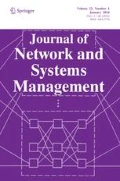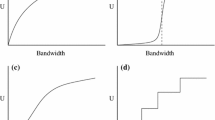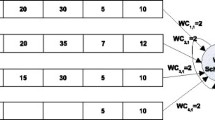This paper introduces a framework to support explicit rate congestion control for best-effort service in MPLS networks. We devise the two basic mechanisms required, namely, a signaling component to convey explicit-rate congestion control information and associated algorithm for calculating explicit fair rates. The proposed signaling component uses Resource Reservation Protocol (RSVP) in a novel way to convey explicit rate congestion control information. An algorithm to calculate Weight Proportional Max-Min (WPMM) fair rates appropriate for MPLS networks is introduced. Simulations are presented that show the effectiveness of the RSVP explicit rate signaling method when combined with the proposed max-min fair rate algorithm.










Similar content being viewed by others
REFERENCES
E. Rosen, A. Giswanathan, and R. Callon, Multiprotocol Label Switching Architecture, RFC 3031, January 2001 http://www.ietf.org.
R. Braden, L. Zhang, S. Berson, S. Herzog, and S. Jamin, Resource Reservation Protocol (RSVP), RFC 2205, September 1997 http://www.ietf.org.
J. Wroclawski, The Use of RSVP with IETF Integrated Services, RFC 2210, September 1997 http://www.ietf.org.
The ATM Forum Technical Committee, Traffic Management Specification version 4.0, af-tm-0056.000, April 1996 http://www.atmforum.com.
R. Jain, Congestion Control and Traffic Management in Atm Networks: Recent Advances And A Survey, ATM Forum Contribution 95–0177, 1995.
S. Kalyanaraman, Traffic Management for the Available Bit Rate (ABR) Service in Asynchronous Transfer Mode (ATM) Networks, Ph.D. Thesis, Ohio State University, Chapter 4, 1997.
F. Skivée and G. Leduc, A Distributed Algorithm for Weighted Max-Min Fairness in MPLS Networks, Proc. of 11th IEEE International Conference on Telecommunications (ICT’2004), Fortaleza, Brazil, 2004.
R. Boutaba, W. Szeto, and Y. Iraqi, DORA: Efficient Routing for MPLS Traffic Engineering. Journal of Network and Systems Management, Vol. 10, No. 3, pp. 309–325, September 2002.
P. Marbach, Priority service and max-min fairness. IEEE /ACM Transactions on Networking, Vol. 11, No. 5, pp. 733–746, October 2003.
D. Awduche, L. Berger, D. Gan, T. Li, V. Srinivasan, and G. Swallow, RSVP-TE: Extensions to RSVP for LSP Tunnels, RFC 3209, December 2001 http://www.ietf.org.
D. P. Bertserkas and R. Gallager, Data Networks, Prentice Hall, Englewood Cliffs, NJ, 1992
Y. Thomas Hou, Henry Tzeng, Shivendra S. Panwar, and Vijay P. Kumar, A Generic Weight-Proportional Bandwidth Sharing Policy for ATM ABR Service. Performance Evaluation, Vol. 38, pp. 21–44, 1999.
T. Quan Le and Tapio Erke, A Combination of ERICA+ and Distributed WPMM Algorithms to Guarantee the Minimum Cell Rate for ABR Service in ATM Networks. Proceedings of the International Symposium on Performance Evaluation of Computer and Telecommunication Systems L. (SPECTS), Montreal, Canada, July 2003.
L. Kalampoukas, A. Varma, and K. K. Ramakrishnan, An Efficient Rate Allocation Algorithm for ATM Networks Providing Max-Min Fairness, Proceedings of the 6th IFIP International Conference on High Performance Networking, 1995.
Qi Wangdong and Xie Xiren, The structural property of network bottlenecks in maxmin fair flow control. IEEE Communications Letters, pp. 76–77, March 1998.
WK. Tsai and M. Iyer, Constraint precedence in max-min fair rate allocation. IEEE International Conference on Communications (ICC), pp. 490–494, 2000.
The Network Simulator Version 2.28 (NS2), http://www.isi.edu/nsna.
The MPLS Network Simulator version 2, http://flower.ce.cnu.ac.kr/~fogl/nms.
D. Adami, C. Callefari, S. Giordano, F. Mustacchio, M. Pagno, and F. Vitucci, Overview of the RSVP-TE Network Simulator: Design and Implementation. Proceedings of Internet Performance, Simulation, Monitoring and Measurements (IPS-MOME), pp. 276–281, March 2005.
M. Greis, The RSVP Module for NS2, http://titan.cs.unibonn.de/~greis/rsvpns_index.html.
RSVP-TE Patch for NS2, http://www.ideo-labs.com.
C. Williamson, A Performance Study of ABR Traffic Control Strategies Using the ATM-TN Simulator, TeleSim Project Report, Department of Computer Science, University of Saskatchewan, April 1998.
R. Jain, S. Fahmy, S. Kalyanaraman, and R. Goyal, The ERICA Switch Algorithm for ABR Traffic Management in ATM Networks, Part II: Requirements and Performance Evaluation, Paper submitted to the IEEE/ACM Transactions on Networking, January 1997.
Author information
Authors and Affiliations
Corresponding author
Additional information
Christopher Marty received a B.S in Electrical Engineering from Rutgers University, an M.S. in Computer Engineering from the New Jersey Institute of Technology, and is currently a Ph.D. candidate in Electrical Engineering at the City University of New York. His research interests include networking, distributed systems, and computational finance.
Mohamed A. Ali is a professor at City College of the City University of New York. His current research activities involve optical communication systems and IP/MPLS high-performance networking. He has published over 100 papers in professional journals and international conferences. He is a recipient of the National Science Foundation faculty career development award.
Rights and permissions
About this article
Cite this article
Marty, C., Ali, M.A. A System for Weighted Max-Min Congestion Control in MPLS Networks. J Netw Syst Manage 14, 537–558 (2006). https://doi.org/10.1007/s10922-006-9041-x
Published:
Issue Date:
DOI: https://doi.org/10.1007/s10922-006-9041-x




